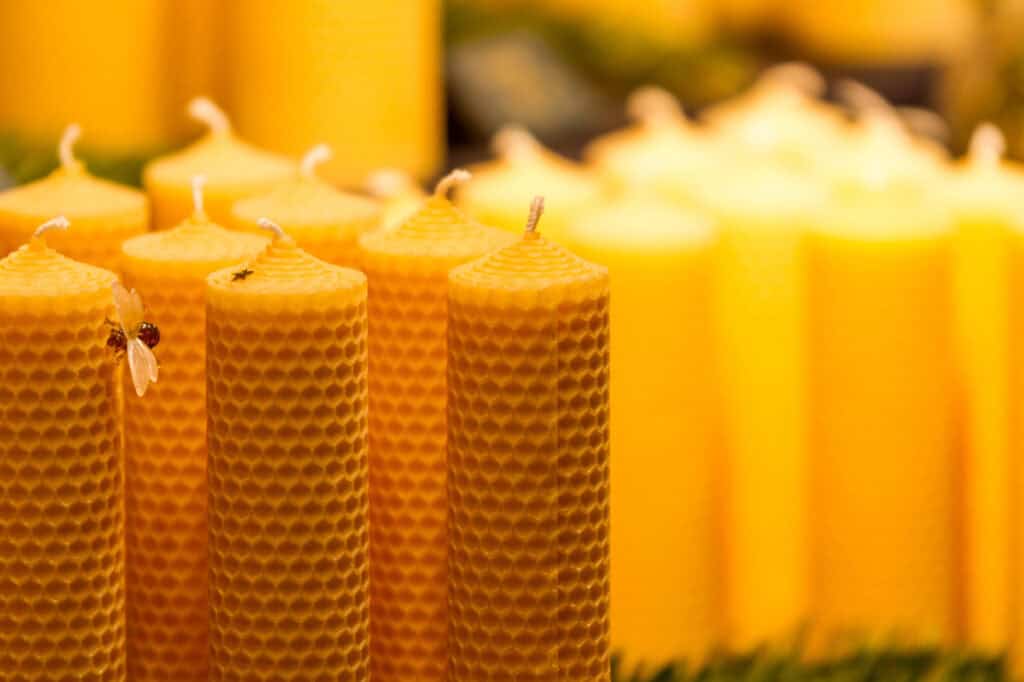“Burning an aromatherapy candle made of paraffin is similar to preparing a healthy drink of fresh-squeezed juice and adding a shot of gasoline.”
~ Eric Johnson, wholesaler of nontoxic aromatherapy candles
By Sarah Campise Hallier
Candle use is steeped in tradition, practicality, and sentimentality. One of the most common motivations is their ability to create a warm and inviting atmosphere. The soft flicker of candlelight can instantly transform a space, evoking a sense of coziness and relaxation. Candles are often used in rituals, ceremonies, and religious and spiritual practices. They are also functional as a light source during power outages or in remote locations where electricity is unavailable. Additionally, scented candles are appreciated for their ability to conjure up memories, elevate mood, and mask odors, making them popular for aromatherapy and ambiance enhancement. Candles continue to hold a cherished place in human culture and everyday life.
But unfortunately there are darker aspects of burning candles. Derived from petroleum, coal, and oil shales, paraffin wax is the reigning champion in the candle industry due to its affordability and accessibility. In 2022, over 45% of candles sold in the United States were made of paraffin wax. Research shows that burning paraffin releases a slew of toxic compounds, including benzene and toluene into the air. Both chemicals have been linked to various health issues, ranging from respiratory problems to cancer. The synthetic fragrances of scented candles further add to the potential risks, highlighting the need for a more conscientious approach to candle burning.
Interestingly, a widely-referenced 2014 study asserted that paraffin wax candles didn’t present known health risks to consumers. It noted that carcinogenic compounds emitted during burning, such as benzene and formaldehyde, were within acceptable limits set by the World Health Organization (WHO). However, critics pointed out that the study was conducted by scientists with ties to candle manufacturers, such as SC Johnson & Son and Procter & Gamble, decreasing its credibility.

The Dangers of Burning Paraffin Candles
In contrast, a 2015 study by researchers affiliated with a South Korean university discovered that paraffin wax candles emit volatile organic compounds (VOCs) both before and during burning:
“VOCs are emitted as gasses from certain solids or liquids…and include a variety of chemicals, some of which may have short- and long-term adverse health effects. Concentrations of many VOCs are consistently higher indoors (up to ten times higher) than outdoors.”
The South Korean study suggested that scented candles could significantly contribute to VOC emissions in indoor environments. According to the Ohio Department of Health:
“Because VOCs create strong odors, even relatively low levels can cause eye, nose and throat irritation, headaches, nosebleeds, fatigue (tiredness), nausea, and dizziness.”
Additionally, Dr. Farooq with the Cleveland Clinic explained that several studies suggested an association between candle burning and bladder cancer:
“All these volatile organic hydrocarbons accumulate in the blood,” she explains. “They eventually get excreted through the bladder, hence the link with bladder cancer.”
In addition, candle wicks made with lead can be extremely toxic when burned and inhaled. According to a study at the University of Michigan, 15 different types of candles were examined from the United States, China and Mexico. “After one hour, five of the candles tested emitted unsafe levels of lead into the air that measured greater than 1.5 micrograms per cubic meter,” (the U.S. Environmental Protection Agency’s maximum recommendation is 1.5 micrograms per cubic meter).
Although the manufacturing and sale of lead candle wicks were banned in the United States in 2003 (and in many other countries since then), the import candle industry is incredibly difficult to manage. With millions of candles making their way to the U.S. annually from countries that do not have regulations regarding lead wicks, how can you be sure what you’re getting? “Lead exposure occurs when a [person] comes in contact with lead by touching, swallowing, or breathing in lead or lead dust.” Candle burning with lead wicks can cause dangerous reactions in many, but particularly in pregnant women and children.
For thousands of paraffin production workers, significant health hazards are present when handling the manufacturing of paraffin wax. The Occupational Safety and Health Administration’s (OSHA) severe injuries reports include work-related injuries from establishments under federal OSHA jurisdiction. OSHA reported amputation, loss of an eye, and inpatient hospitalization for oil and gas extraction (OGE) workers from 2015 to 2022.
In addition, “Exposure to fumes and handling hot wax can result in respiratory problems, skin irritations and other health issues.” Fumes and overheated paraffin vapors can also cause eye irritation. Direct contact with paraffin wax can cause ocular damage and burns. The pervasive health hazards associated with paraffin production emphasize the critical need for comprehensive safety measures for paraffin manufacturing and production, clearly indicating the risks associated with this occupation.
Paraffin wax also poses significant environmental and economic challenges throughout production. As industries worldwide continue to demand increasing amounts of fossil fuels, efficient extraction and use of oil and gas are crucial. However, paraffin wax contributes to serious problems. When the wax reaches high enough temperatures, its crystalized form can create blockages within the pipelines, and corrosion, leading to substantial economic losses for the petroleum industry.
Additionally, as waxy crude oil is increasingly exploited, and paraffin has widespread industrial applications, large quantities of it are released into water supplies, including streams and oceans. This has led to detrimental consequences, with paraffin wax being recognized as a prevalent marine pollutant. The global production and usage of paraffin wax-based products have reached staggering levels, exacerbating environmental concerns. Addressing these issues is not only essential for meeting economic and energy demands, but also for ensuring sustainable environmental protection.
Then why use paraffin? Crude oil (also referred to as petroleum), a natural fossil fuel, serves as the primary material for producing paraffin wax. This substance is a complex blend of hydrocarbons. Through a refining process, crude oil undergoes fractional distillation, where its components are separated based on their boiling points. The remnants left behind after the distillation process, known as “slack wax,” serve as the precursor to paraffin. Essentially, this wax is made from the leftovers of refining crude oil, after they’ve removed gasoline and diesel. The wax is produced by boiling the oil, and separating out different parts based on how hot they get. Paraffin wax is what’s left from the heavier parts that don’t evaporate as efficiently.
The ease and inexpensive production of paraffin wax makes it a popular choice for candle-making because it creates smooth and sturdy candles, especially when produced by machines. It is cost-effective and easy to work with because it pours and hardens consistently. The wax has a high melting point, which helps preserve fragrances and colors. It also tends to burn evenly, and for a long duration. Paraffin wax is used in a myriad of products worldwide, from cosmetics, dentistry for denture fabrication, wax papers, base for medical ointments, waterproof coating for wood, extraction of perfume from flowers, and tanning agents for leather. Its versatility makes it widely-favored and effortlessly adaptable.

Other Types of Candle Wax
Reluctant to part with your beloved candles? Fortunately, there are options available other than traditional paraffin wax. With a growing number of health-minded and eco-conscious consumers on the lookout for alternatives, you can find candles that align with your health values, and promise delightful sensory indulgence. Most importantly: When sourcing ingredients, look for “nontoxic, no chemicals, and no paraffin.”
- Beeswax: Natural and nontoxic, beeswax candles are the safest to use, and may even be beneficial if you have allergies or asthma. When burned, beeswax candles emit negative ions, which can help purify the air by neutralizing pollutants and allergens. Due to their higher melting point, they have a longer burn time than paraffin candles. Beeswax candles emit a natural honey-like scent without the need for fragrances. If you do enjoy a particular scent, you can source candles infused with essential oils only.
- Soy: Candles made from soybeans are biodegradable and produce less soot and toxins than paraffin, resulting in cleaner air quality. They typically burn slower and cooler than paraffin, providing a longer-lasting burn time. But make note: 1. Many soy candles contain toxic synthetic fragrances and dyes. 2. 90+% of soy crops are genetically-engineered, so you will be supporting Monsanto and the production of harmful herbicides/pesticides if you purchase them. From Happy Flame:
“96% of soybeans grown globally are Monsanto genetically- modified (GMO) soy beans. PLUS there is a huge amount of pesticides and other chemicals being used in soybean farming which may stay with soy when processed.”
- Palm: Increased use of palm oils and products have led to massive deforestation, affecting animals as well. Palm wax can be sustainably-sourced from palm oil plantations that adhere to responsible farming practices, such as RSPO certification. However, be aware that palm wax candles are often made from a blend of soy and palm. From “Best & Worst Non-Toxic Candles 2022”:
‘“Palm oil comes with baggage, whereas endangered animals are brought to the brink of extinction, primal rainforests destroyed, farmers driven off their lands, and peat fires causing devastating air pollution throughout the entire region in places like Indonesia. Careful who supplies your palm oil!”’
- Coconut: Candles made from coconut produce minimal soot and smoke, resulting in cleaner air quality indoors. Coconut wax has a creamy texture and excellent scent, providing a luxurious candle experience. But buyer beware: Similar to palm wax candles, many coconut candles are a blend—they are not made from 100% coconut wax. They may be mixed with soy or paraffin, so investigate the ingredients. If the listing does not seem transparent, and you can’t ask the candle maker, don’t buy them.
It’s important to be diligent in label-reading when purchasing candles. If you aren’t sure, carefully research the manufacturers to ensure the ingredients are what you’re looking for.
“As with many products today labeled as natural, organic, or eco-friendly, unscrupulous makers and manufacturers word their product descriptions very carefully to mislead consumers.”
Beyond the Candle
Looking to create a home environment that offers soothing scents and soft lighting? These creative solutions provide ambiance and fragrance without the safety concerns of traditional candles. This makes them perfect for creating a cozy atmosphere in any space.
- Oil diffuser with organic oils: Using heat or ultrasonic technology to disperse organic essential oils into the air, oil diffusers give off a natural and pleasant aroma. A heat diffuser operates by using heat to transform water mixed with a few drops of essential oil into a vapor that spreads into the air. These devices can either be electric or utilize the warmth from a candle or flame. You can mix and match different organic oils to create personalized scent combinations, catering to individual preferences. Many organic oils have therapeutic properties, such as relaxation, mood uplift, or stress relief. Oil diffusers operate without an open flame, making them a safer option, especially in households with children or pets.
- Organic simmer spices: Simmering organic spices such as cinnamon sticks, cloves, or citrus peels on the stove releases their natural fragrance into the air, creating warmth, and a delicious, inviting aroma. As these ingredients are often readily available in the grocery store, boiling water at a low temperature and adding spices is a cost-effective way to add ambiance to your home. You can experiment with different spice combinations to create unique scents that suit various occasions or seasons.
- Solar candles: Designed to mimic the flickering glow of real candles, solar lights provide ambiance without the risk of fire hazards. Some come with remote controls, allowing you to adjust brightness levels or set timers for automatic shut-off.
- Wine bottle lights: Repurposing empty wine bottles into decorative lamps by inserting solar string lighting, wine bottle lights add a charming, eco-friendly touch to home decor. They emit a soft, ambient glow, ideal for creating a cozy atmosphere during dinner parties or intimate gatherings. You can customize them with different colored lights or visual accents, showcasing your creativity and personal style.

Whatever your motivations for lighting candles, consider healthier alternatives to using paraffin wax. Because your health and that of the environment are paramount, making conscious decisions in this area can improve the quality of your life, and the lives of others. When selecting candles for your personal space, reflect not only on their aesthetic appeal, but also on their impact. Choosing natural waxes and essential oil (preferably organic) scents will provide an earthy, clean feeling, free of heavy, burdensome substances. And if you’ve felt bogged down by allergies or sensitivities when burning traditional candles, switching to unscented beeswax candles may be a refreshing experience.
Here are a few final tips to selecting your earth-friendly candles:
- Choose lead-free wicks made from 100% cotton.
- Watch out for labels that say “blend,” as paraffin is likely part of the mix.
- Look for “100% beeswax,” as candles made from at least 51% beeswax (thus mixed with other waxes) may be labeled “beeswax.”
- Ask for candles with wicks that have been primed with beeswax, not paraffin, which many candle companies (beeswax sellers included) use.
~
Published on May 30, 2024.
If you’ve found value in this article, please share it!
To support the research and health education of AVFC editorial, please consider making a donation today. Thank you.

